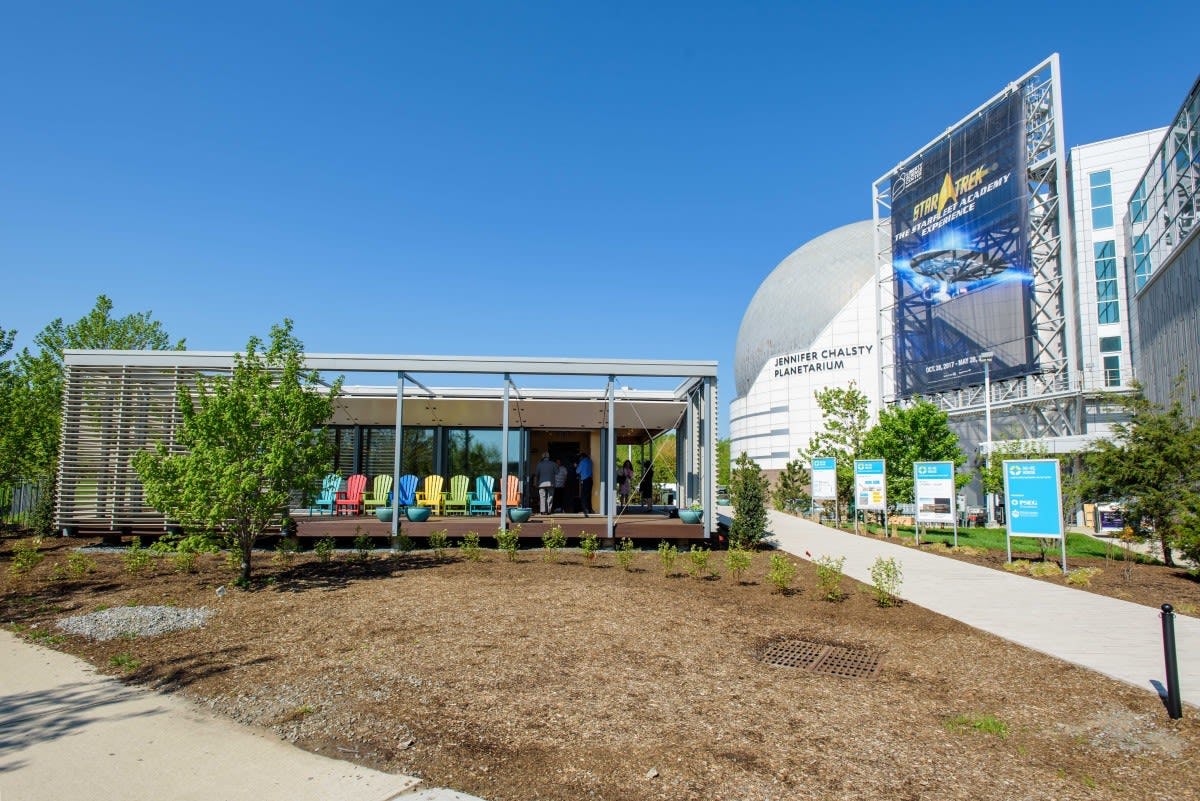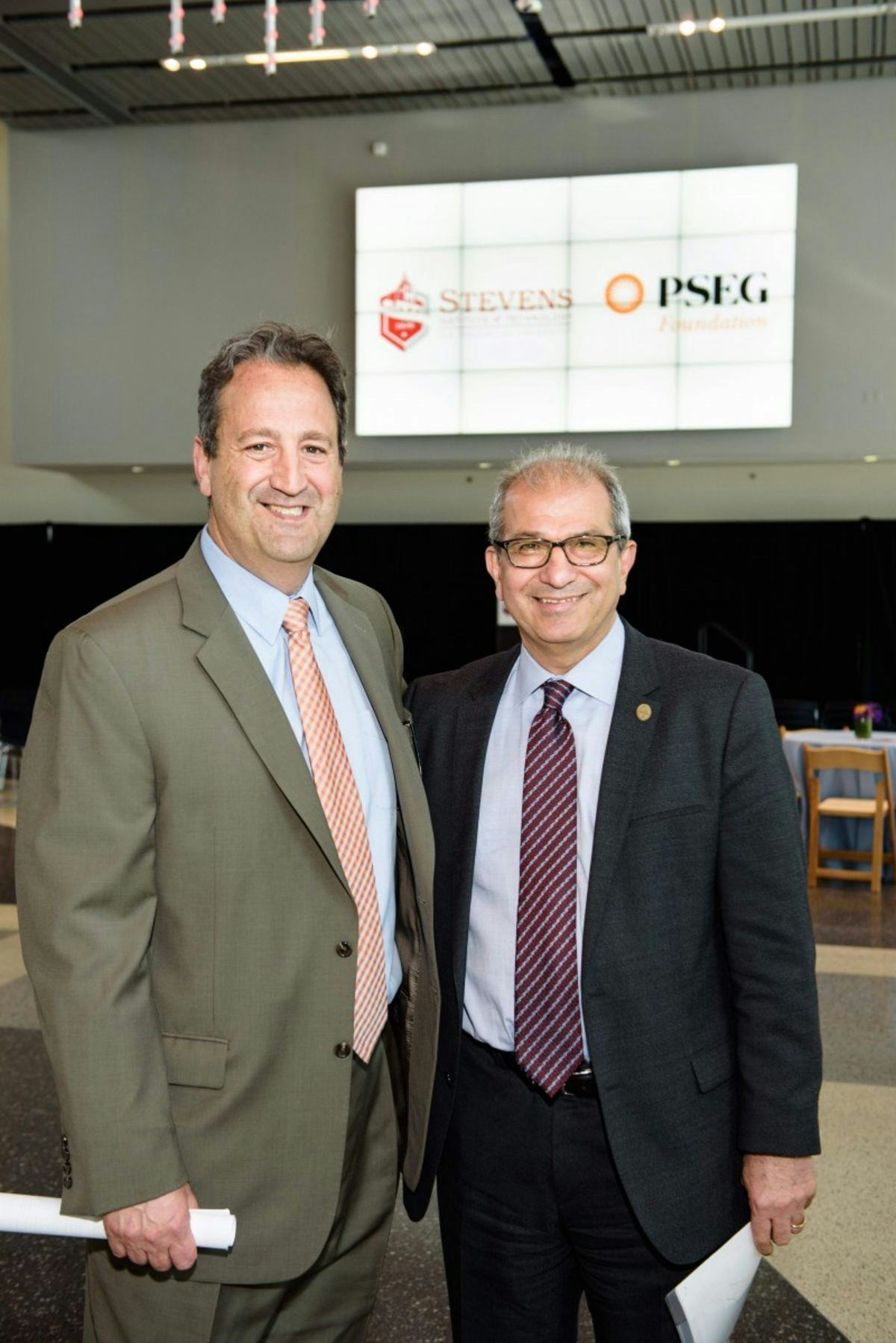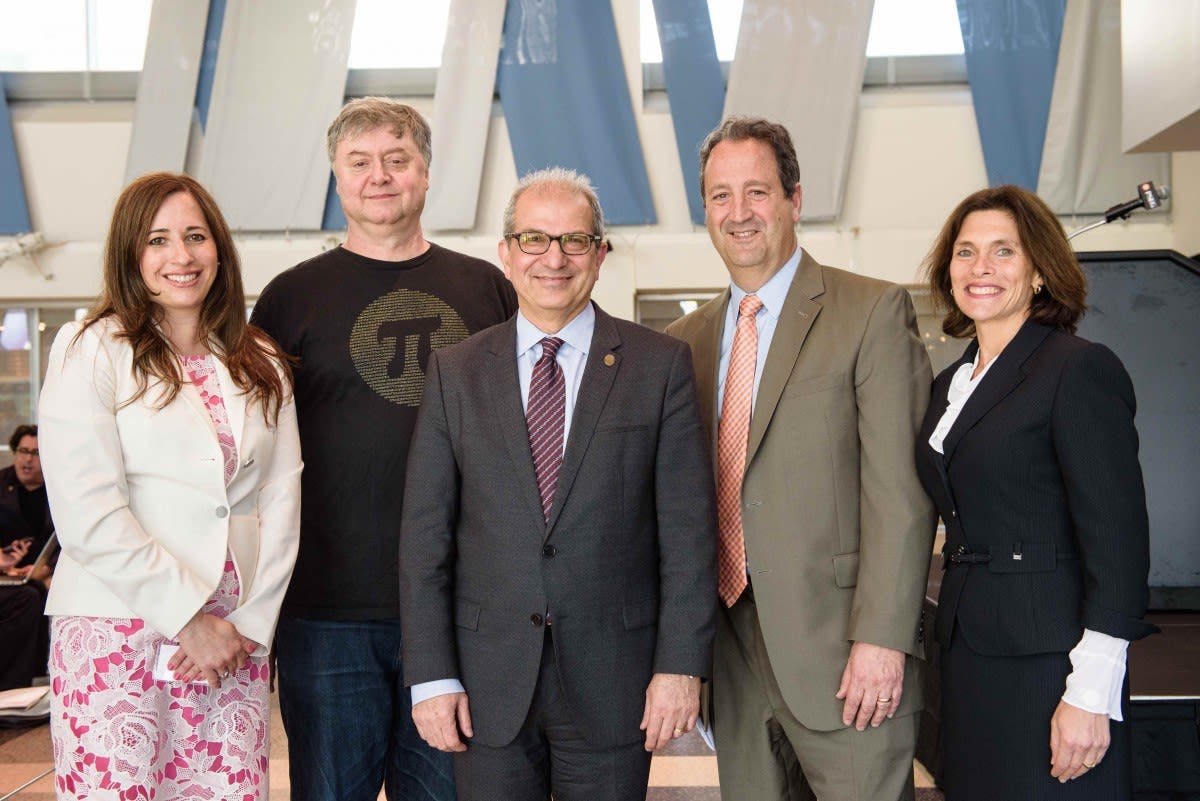Stevens and PSEG Celebrate Partnership at Liberty Science Center
On May 8, 2018 Stevens Institute of Technology and Public Service Enterprise Group (PSEG) celebrated a partnership focused on energy innovation, public service and arts and cultural programming.
The celebration brought key stakeholders of Stevens and PSEG together at the Liberty Science Center in Jersey City, New Jersey, to celebrate a fruitful ten-year partnership, and the beginning of a promising new initiative that Stevens President Nariman Farvardin described as a "partnership on steroids."
The event opened with remarks by industry professor and director of Stevens product architecture and engineering program John Nastasi. He emphasized the long-term partnership between PSEG and Stevens as "one that has deep roots, impact, and will endure for a long time." He explained how the strategic goals of PSEG align with Stevens in many ways, especially in creating new energy technologies as well as PSEG’s extensive efforts to improve local communities "by supporting education, emergency preparedness, public safety and the arts." Stevens is committed to those same goals, especially by "cultivating, enrolling and empowering talented students from a diverse set of backgrounds," Nastasi said.
Pursuing Energy Innovation and Public Service
Because those strategic goals align, Stevens and PSEG "have a close and mutually beneficial relationship" that produced a $1.5 million dollar award designed to strengthen the mutual pursuits of energy innovation and public service. In order to pursue energy innovation, Stevens has created a highly collaborative, multidisciplinary faculty team to produce flexible photoelectronics and sustainable fuels suitable for energy conversion. Faculty members leading this research include Stephanie Lee who will be creating flexible solar cells and renewable energy applications and Nicholaus Parziale who will work on fast pyrolysis of biomass.
This PSEG partnership will also allow Stevens to invest in undergraduate and Ph.D. research scholarships as well as new technical instrumentation.
"Through the generous support of a PSEG Ph.D. fellow, the PSEG partnership has enabled my team to expand our research beyond flexible solar panels to the field of solid-state batteries," said Lee. "This collaborative effort with professors Dilhan Kalyon and Jae Chul Kim will leverage our collective expertise in the processing and characterization of soluble functional materials to develop methods for continuously manufacturing high-performance flexible batteries that are both safe and effective. Having an industry partner like PSEG who is actively investing in battery technology will be invaluable in guiding our research in a manner that is aligned with commercial needs and requirements."
"My research will focus on constructing and characterizing a reciprocating biomass conversion reactor, which is a novel means to efficiently produce bio-oil by fast-pyrolysis," said Parziale, describing processes which have the potential to provide a distributable, low-carbon energy source that can combat climate change. "We believe that the reactor can aid in solving the problem of high cost for biomass conversion and upgrading to biofuels… and since PSEG is looking for new tools to provide their customers with better service, and researchers like us at Stevens are trying to create those tools, I think the PSEG partnership is a unique opportunity to close that loop."
Sustainable and Resilient Award-Winning Housing
The event continued with Nastasi discussing a generous PSEG Foundation grant that helped fund the construction of Stevens’ Sustainable and Resilient (SU+RE) House. The SU+RE House is a sustainable and resilient housing structure designed in the wake of superstorm Sandy to safely withstand similar flooding conditions. It was submitted to the 2015 U.S. Department of Energy’s Solar Decathlon under Nastasi’s supervision, and he expressed his pride in the Stevens team winning top honors over other notable schools including Yale University, Clemson University and the University of Texas at Austin. PSEG also enabled the transportation of the SU+RE House to Liberty Science Center, where it will benefit the public as a permanent attraction and information center.
PSEG’s impact will also benefit younger students and inspire their interest in STEM areas of study. Because of PSEG’s generosity, over 100 youth from underserved communities will engage in hands-on engineering design challenges that expand their understanding of renewable energy resources and power generation. Led by the Center for Innovation in Engineering and Science Education (CIESE) at Stevens, teams of middle school students will design, build, and test solar-powered devices, wind turbines and much more. They will visit cutting-edge research labs and meet Stevens students and professors – a fun-filled week guaranteed to spark their interest in STEM.
"A Partnership on Steroids"
President Farvardin then spoke about the "deep and recently re-energized partnership" between Stevens and PSEG. He discussed the depth of Stevens partnership with PSEG as a pipeline for talent, stating that "more than 200 Stevens students have worked or are currently working at PSEG." He also thanked PSEG for its efforts in supporting CIESE since its creation in 1988, including its support this year for the pre-college program as well as a new PSEG-supported summer middle school program called "Energy Abounds" where 40 middle school students from underserved communities will learn about energy creation. "Generations of students have benefitted from your generosity," President Farvardin said. He expressed his hopes that this new partnership and all its initiatives would inspire even more, and become a "transformational model" used not only for Stevens and other industry partners, but for other universities across the country.
Ralph LaRossa '90, president and chief operating officer of PSEG, spoke next. He thanked both Paul Hoffman, president and chief executive officer of Liberty Science Center, and President Farvardin for their leadership in building partnerships with PSEG that enable the company to not only fulfill its strategic goals but also exceed them. He then described being impressed by the SU+RE House, stating that he would never forget the impact of superstorm Sandy on local communities. He also reaffirmed PSEG’s commitment to STEM education by sharing his hopes for the installation of the SU+RE House at Liberty Science Center: "When 700,000 kids walk through here and see [the SU+RE House], hopefully they’ll be as energized as I was to learn about science and math."
Jean Zu, dean of the Charles V. Schaefer, Jr. School of Engineering and Science spoke next, expressing her excitement of the "deep support" the Schaefer School is receiving from PSEG. She stated that is "very proud of the work [the Schaefer School] is doing in energy innovation," and expressed her hopes that the school will be able to do even more through this generous partnership. "PSEG is helping strengthen our faculty," she said, explaining that the grant made it possible to hire professor Jae Chul Kim from Massachusetts Institute of Technology to pursue his research in energy storage with Stevens. "Our partnership with PSEG will help Stevens continue pushing into new frontiers of knowledge, learning and scholarship. We’re so grateful to have such a partner and we look forward to many future collaborations and successes," she said.
"The Power of Stevens"
Stevens assistant professor Stephanie Lee spoke next, describing her research in building lighter, safer, more powerful flexible batteries. "Imagine a world where installing solar panels is as easy as painting them on your roof," she said. She’s working to create them, and expressed gratitude at PSEG’s support and guidance. "In the silo of academia, it’s easy to lose touch with real-world applications," she said. "Connections and collaborations with industry partners like PSEG, solving real-world problems on the front lines, are invaluable in guiding the direction of academic research in order to achieve the highest level of impact."
Lastly, Stevens civil engineering senior Yonaida Brito spoke, explaining how support from companies like PSEG enabled her to succeed as a woman in STEM. "My family moved to the U.S. from the Dominican Republic when I was seven," she said. "We were very poor. My parents didn’t even finish high school. They struggled to make ends meet, but they wanted me to have everything they didn’t and prioritized my education." When she got accepted into Stevens, her family scraped together every penny to pay for her education, but after receiving scholarships from Stevens, "after freshman year, I never asked them them for a penny," she said. "In fact, due to internships at companies like HDR and Skanska, I was able to give back to them. It was at Stevens where I truly found myself." Now, as she’s about to graduate Stevens and begin working as a project engineer for Gilbane Building Company, she offered specific words of praise for PSEG: "Thank you for believing in the power of Stevens."
All in all, the event was a wonderful assertion of support between Stevens and PSEG, and a harbinger of even greater partnership to come.





